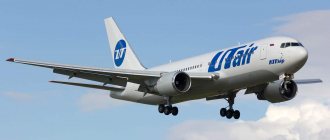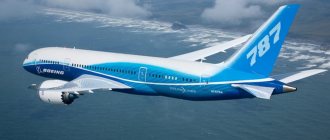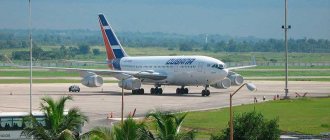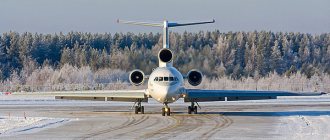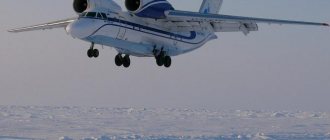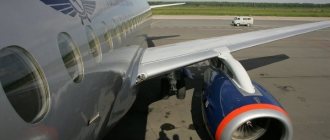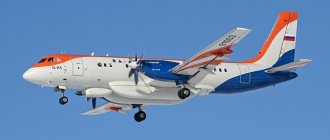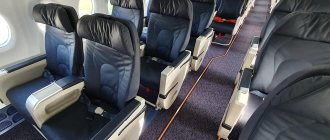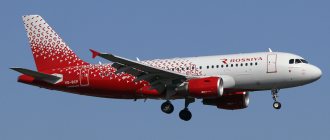The Boeing 727 narrow-body passenger airliner, created at the same time as the Soviet Tu-154 aircraft, had an almost identical layout. Both aircraft formed the backbone of domestic air transportation in the USA and USSR, respectively, were actively exported and remained in operation for almost 50 years.
By December 1977, 727s had carried their first billion passengers, a feat no passenger car had ever achieved before. By the time passenger traffic ceased, the liners carried at least 4 billion passengers.
History of creation
In the process of creating the long-haul Boeing 707 airliner, the company received wishes from leading air carriers regarding machines for short and medium distance flights. At that time, there was a rapid increase in the air transportation market, which led to the appearance of aircraft with a compact layout of passenger cabins and elongated fuselages.
The machines were required to operate from short runways and have extended maintenance intervals. The latter requirement made it possible to reduce aircraft downtime in repair areas.
Since the total order for new aircraft was estimated at only 300 aircraft, the design was supposed to use the maximum possible number of components from the Boeing 707 and 720 airliners. Initially, a four-engine layout or the option of installing engines in pairs on the rear fuselage was considered. But in the end, a compromise option with three engines located at the rear of the vehicle won.
For the future Boeing 727, it was planned to use a licensed version of the Rolls-Royce Sprey engine produced by Allison. But then this idea was abandoned in favor of Pratt&Whitney JT8D series turbojet engines.
The first flight of the new airliner took place in the winter of 1963, and after some time an exhibition model was ready, which was demonstrated to airline representatives.
The commercial pioneer of the Boeing 727-100 was Eastern Air Lines, which operated its first flight in February 1964. United Airlines was only five days behind its competitor.
The very first flights showed the economic efficiency of the airliner, which was ahead of even twin-engine aircraft like the Caravella. Moreover, the advantage remained even on short routes. But the efficiency of the aircraft did not contribute to the growth of demand - by mid-1964 the company had only 200 firmly ordered aircraft.
To revive demand, a stretched version was developed under the designation Boeing 727-200. The vehicle was equipped with a fuselage with two additional inserts, each 3050 mm long, installed on either side of the axis of the main landing gear. At the same time, the remaining components of the machines remained unchanged.
The first commercial user of the aircraft was Northeast Airlines - the flight took place in mid-December 1967. At this point, Boeing had more than 500 orders for the 727 model, with the stretched version accounting for almost 25% of the volume.
By 1973, Boeing retired the short version of the 727-100, having produced just over 500 aircraft.
A significant blow to the popularity of the 727 model was dealt by the more efficient Boeing 737, which began production in the late 60s. Demand partially recovered only in the second half of the 70s, with customers buying mainly transport versions.
The extended version remained in production until 1984 and ensured that Boeing maintained its leading position in the market for commercial aircraft with turbojet power plants. In total, the corporation delivered 1,831 aircraft to customers.
Almost 34 years have passed since the last production Boeing 727-200 was handed over to the customer, so only aircraft are actively used. Single cargo aircraft are found in Asia, Africa and Latin America. In the United States, the last operator of the aircraft was the charter company Champion Air.
At the time of the collapse that occurred in 2008, the airline had 16 Boeing 727 and 727-200 aircraft on its roster. After the bankruptcy procedure, all cars were sold for scrap.
The reason for the emergence of a new passenger airliner
In the United States, by the 1960s, the domestic passenger airline fleet consisted of older propeller-driven aircraft. The same planes connected US cities with the countries of the Caribbean and Latin America. It should be noted that despite the high degree of reliability of piston and turboprop passenger airliners, they flew slowly. Medium-haul L-1049 Super Constellation or Douglas DC-7C aircraft covered the distance from New York to Los Angeles in 6-7 hours. It will take another ten years before the Boeing 727 regional passenger airliner appears, a machine that can connect remote regions of a huge country.
Civil aviation in the United States has just begun the transition to jet aviation. The design bureaus of the Douglas Aircraft Company and Boeing were actively working on creating new jet aircraft. The United States in this regard lagged behind the British and the Soviets, where the first jet passenger aircraft, the Comet and Tu 104, had already been created.
If the situation with machines capable of flying long distances was resolved with the appearance of the first-born American jet passenger aircraft, the Boeing 707, and then the competing aircraft DC-8, then for domestic airlines the aircraft had to be created almost anew. Moreover, the situation on the domestic air transportation market was becoming catastrophic. The growth in the number of potential passengers pointed to the need to create a car with a larger passenger capacity that would take a passenger from Washington to New Orleans, from Anchorage to Houston or to San Francisco in two to three hours.
The success that accompanied the appearance of the new Boeing 707 jet passenger airliner on international routes prompted the main United States air carriers, Pan American, United Airlines and WTA, to jointly decide on the need to build a regional airliner. The aircraft manufacturing company Boeing was chosen as the main developer. The tasks that were put forward to aircraft designers were as follows:
- the new aircraft will have to be able to take off and land on shortened runways;
- the machine must have the necessary margin of safety and reliability in the event of emergency situations on board;
- the aircraft must be easy to maintain and easy to operate;
- the car must be fast, roomy and at the same time economical.
The Boeing offices were well aware that it would not be possible to make a new aircraft by modernizing the 707. It was impossible to simply lengthen the fuselage of the base model to increase passenger capacity. To lift such a machine into the air, a larger wingspan and powerful engines will be required. Accordingly, the aircraft's landing gear will have to be reinstalled due to the increase in the size of the airliner. Under such conditions, there was no need to talk about creating a compact and capacious machine capable of being serviced at small regional airports. It was this argument that became decisive in favor of the decision to build a completely new aircraft.
Design
The Boeing 727 is a cantilever monoplane with a low-swept wing and a power plant of three turbojet engines. The air intake of the central engine is located on the upper part of the fuselage. Due to the installation of the engines in the tail section, a tail unit with an upward horizontal stabilizer was used.
Additionally, there is a gas turbine engine with a generator, which ensures the independence of the aircraft's electrical system from ground equipment. A similar installation began to be used on Boeing passenger aircraft precisely with the 727 model.
The wing profile was obtained as a result of numerous wind tunnel tests.
For the first time in world practice, three-slot flaps were used on the wing. Additionally, the mechanization of the wing planes includes slats.
The use of these units made it possible to take off and land from strips of about 1600 m in length. In the early 90s, attempts were made to install vertical aerodynamic ridges on the wing plane. Theoretically, the modernization made it possible to reduce fuel consumption by 4%.
Boeing 727 aircraft are equipped with Collins or Honeywell avionics systems. Electromechanical devices are used to indicate readings. During later modernizations, devices with liquid crystal screens were used on some machines. Similar equipment has been installed on FedEx transport aircraft since 1994. The crew consists of three people, although the possibility of using a two-seater cabin was explored.
The Boeing 727-200 passenger cabin has two layout options - only economy class or with an additional business class.
The seats for business passengers are located at the beginning of the cabin, installed in pairs in two rows. Behind them is an economy salon, which houses three-seater seats with a central aisle. There are three bathrooms on board, located at the beginning and at the end of the cabin.
So hoo from Mr. Cooper?
So, the mystery of Dan Cooper is still not solved. But in principle, it is possible to draw up a psychological and professional portrait. This is clearly a person who has military or sports landing training behind him, and very thorough one (night landing is aerobatics). He clearly has experience as both an international pilot and an aircraft builder (not everyone knows the structure of an aircraft in such detail, the intricacies of its control, an aviation map of the area, etc.). This is precisely what a recent examination of the tie suggests—aircraft particles such as aluminum, bismuth, and titanium were found on it. And in addition, three years ago, during a repeated examination, cerium and strontium sulfide were discovered - they were used in the development of the supersonic civilian Boeing 2707 (the project was closed a year before the hijacking). It is possible that this is a former intelligence officer; he is too well-versed in psychological terms.
And finally, there's a good chance it's not American. After all, Dan Cooper is the name of a comic book hero about the adventures of a Royal Canadian Air Force pilot. This series was not sold in the USA. But in the neighboring country it was a cult. This means that the hijacker could well have returned home to Canada after a successful business. For this reason, the stolen dollars never surfaced in any US store or bank (except for the half-decayed 6,000 found on the river bank in the reserve). Although it is possible that Cooper did not spend them at all and this entire special operation was designed to restore some kind of justice still unknown to us...
Modifications
Based on the initial short version, versions of convertible cargo-passenger vehicles were produced with the designations 727-100C (or in other sources 100F) and 727-100QC (or 100QF). The interior uses a floor with a reinforced structure, which makes it possible to place cargo weighing up to 20,400 kg. The load is installed on special pallets; a total of 8 pallets are placed in the cargo compartment.
For loading there is an additional extended door and a set of special equipment. The dimensions of the loading door are 2180*3400 mm.
Converting a passenger version into a cargo aircraft takes from half an hour (727-100QC version) to two hours (727-100C). Reducing conversion time on the 100QC model aircraft was achieved by using quick-release passenger seats. Both passenger versions can carry 94 passengers. A combined layout option is possible, in which 2-3 pallets with cargo are installed in the front part of the passenger compartment, and then seats for 56-70 passengers are installed.
By special order of the logistics company UPS, a batch of 727-100QF transport vehicles was built. An important difference between these aircraft was the use of Rolls-Royce Tay turbojet engines, which were characterized by reduced noise levels. Such an event made it possible to use cars at airports with increased requirements for engine noise. Single copies of the 727-100 Business Jet were also produced, differing in the layout and cabin equipment.
Based on the aircraft with an extended fuselage, a cargo version of the 727-200F was produced, as well as a special version of the 727-200 Advanced.
The vehicles were distinguished by a reinforced airframe and low-noise engines (with the ability to reverse thrust). To increase the flight range, an additional tank is installed in the wing center section.
Special attention was paid to improving flight safety - an automatic wheel braking system and emergency indicators of dangerous proximity to the earth's surface were used. Later, an automatic thrust regulator was installed on the engines, increasing the output to 7900 kgf in takeoff mode. It was the Advanced version that became the last Boeing 727 built.
The Boeing 727-200 Advanced version became the basis for the cargo version that was supplied to FedEx. The aircraft had an increased height and volume of the cargo compartment and made it possible to transport cargo weighing up to 28,600 kg. A total of 15 machines of this type were assembled. The C-22B and C-22C army vehicles were built by order of the US Air Force. Both variants had a short fuselage. The planes were used to transport high-ranking officials.
Options
- Boeing 727-100
is the original model. - Boeing 727-100C
- Convertible cargo-passenger version. - Boeing 727-100QC
- Quickly change cargo-passenger version. - Boeing 727-100QF
- cargo version for UPS Airlines; to comply with new noise standards, standard engines were replaced with Rolls-Royce Tay (English) Russian. - Boeing 727-100 Business Jet
- Boeing 727-200
- Modified version (extended by 6 meters). - Boeing 727-200F
- cargo version. - Boeing 727-227F Advanced
is a version for passengers to achieve a zero-gravity experience. - C-22
- Military version, specially created for . - C-22B
- Military version of the Boeing Boeing 727-100. - C-22C
- Military version of the Boeing Boeing 727-100.
Boeing 727 performance and safety
Over the more than 50-year history of operation of the Boeing 727, according to various sources, from 114 to 118 aircraft were lost. The victims of aviation accidents involving these airliners were 4,209 people (according to other sources, 3,959 people). Since the period of active operation of the aircraft coincided with the peak of aviation terrorism, a number of Boeing 727 hijackings ended in explosions and crashes. 345 people died at the hands of terrorists.
Below are some machine parameters. It can be clearly seen that the 727 model had greater capacity and less weight compared to the Boeing 720. It was these factors that justified the use of the Boeing 727 on domestic routes.
| Parameter | Boeing 720 | Boeing 727-200 | Tu-154M |
| Length, mm | 41680 | 46690 | 47900 |
| Wingspan, mm | 39880 | 32920 | 37550 |
| Height, mm | 12660 | 10360 | 11400 |
| Take-off weight, kg | 106141 | 95030 | 104000 |
| engine's type | Pratt Whitney JT3D-3 | Pratt Whitney JT8D | D-30KU |
| Number of engines | 4 | 3 | 3 |
| Thrust of each, kgf | 8165 | 5800 | 11000 |
| Cruising speed, km/h | 983 | 965 | 935 |
| Flight range, km | 6687 | 4020 | 3900 |
| Ceiling, m | 12800 | 12192 | 12100 |
| Crew, people | — | 3 | 4 |
| Passenger capacity, persons | 116 | 145-189 | up to 180 |
The Soviet airliner Tu-154M had similar characteristics. The “blame” for the domestic machine can be a slightly lower flight speed with a noticeably higher engine thrust.
Because of this, the profitability of operating a Soviet aircraft is somewhat worse than that of its American counterpart.
Brilliant plan
Honored Test Pilot of the USSR Viktor Zabolotsky to reflect on the mysteries of this story as part of the joint program of Radio “KP” (fm.kp.ru) and the Russian Geographical Society “Club of Famous Travelers” . He knows the type of aircraft where the events took place and was flying over the area where the desperate paratrooper jumped.
“Judging by Cooper's actions, he maximized his chances of survival.” Firstly, this is evidenced by the choice of aircraft itself. The Boeing 727-51 has a built-in stairway at the rear, like on our Yak-40 and Yak-42. This ramp is just convenient to jump from. Any other type of aircraft sharply reduces the parachutist’s chances - they have to “exit” through the side hatch, and this is fraught with a blow to the wing or stabilizer.
— Were there any cases of jumping from civilian aircraft?
- Certainly. When we were doing flight tests in the USSR, a special group of experienced parachutists, so to speak, “jumped” the plane. We lost one parachutist during testing of the Il-62. No matter how the aerodynamicists calculated the safe option, something went wrong and he crashed into the wing. There was such a dent that you could drive half a motorcycle in there...
Secondly, Cooper ensured a safe landing by setting the pilots to a certain altitude - three thousand meters. This is also no coincidence. On the one hand, it is difficult to observe from the ground the moment the parachutist separates. On the other hand, at this altitude there is no depressurization of the aircraft; there will be no bang when opening the door. You can breathe freely and don't need an oxygen mask.
Thirdly, the speed of 350 km/h is not accidental. It is the minimum possible for a flight and comfortable enough to leave the board. If, of course, you have sufficient landing experience.
In culture and art
Boeing 727 aircraft are found in a number of American TV series and computer games. The liner has not been ignored by scale model manufacturers, who produce copies in 1/72, 1/100 and 1/144 scales.
The Boeing 727 aircraft appeared at a time of rapid growth in passenger air travel, when new aircraft models appeared literally every year.
The machine was quickly replaced by more promising developments, gradually relegating itself to secondary roles.
Today, the cars have become almost a thing of history, occasionally found only in remote corners of Africa or South America. Thanks to the experience gained in the creation and operation of Boeing 727 aircraft, the corporation's designers were able to create a number of new aircraft that are superior to their predecessor in all respects.
Stages of the birth of a new Boeing
Initially, the designers were given a difficult task. It was necessary to create a machine that, in terms of its takeoff and landing parameters, could easily use the existing airfield infrastructure in the United States. In addition, such an aircraft had to fly quickly at low altitudes. The key factor in the construction of the aircraft was the profitability of passenger air travel. Who will pay for expensive plane tickets if you can save money by choosing propeller-driven aircraft or traveling by rail?
Short distances for civilian passenger ships have become a stumbling block. The number of takeoffs and landings during the operation of a regional aircraft increased noticeably compared to a similar regime for intercontinental airliners. Accordingly, the car should have had a more durable and stable chassis. The service life of aircraft engines increased. The aircraft design itself had to be ready for quick maintenance in order to reduce the time to prepare the aircraft for a new flight. In this case, American pragmatism played a significant role.
According to airline managers, the operation of the aircraft should generate constant income. The time an aircraft spends on the ground does not generate income. The more flights the car performed, the higher the profitability of transportation. This aspect is reflected in the cabin layout of the new aircraft. Passenger seats were arranged in three rows, on both sides of the central aisle. The number of passengers with this method of boarding was 131 people.
For the new aircraft, it was necessary to create new jet engines. Since most small regional airfields are located within city limits, the noise level of operating aircraft engines must comply with established noise standards.
Parameters and noise standards for jet engines for passenger airliners were first introduced in America and Europe in the early 60s. In the Soviet Union, they started talking about this aspect only in the early 80s, when the technical opportunity arose to make powerful and less noisy jet engines.
